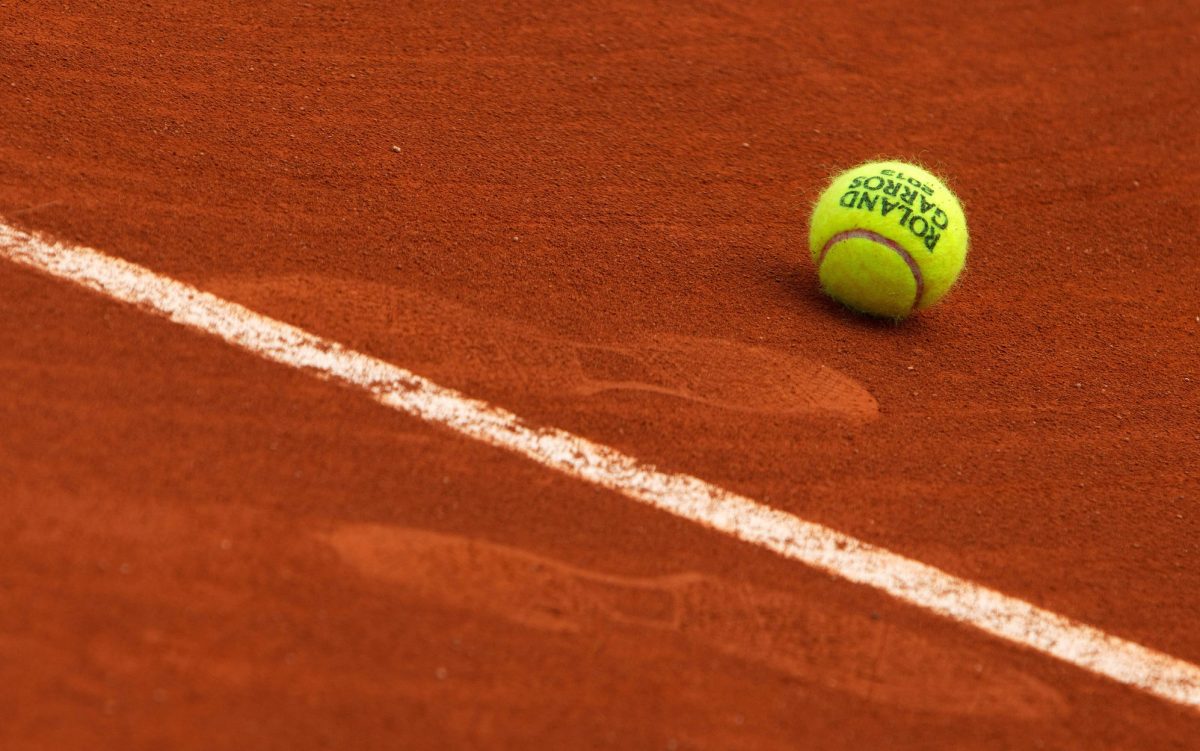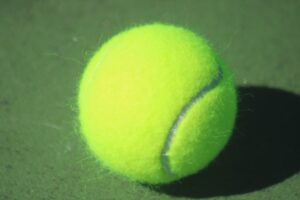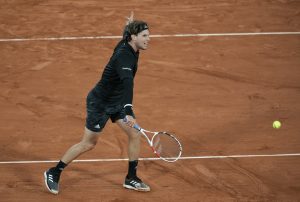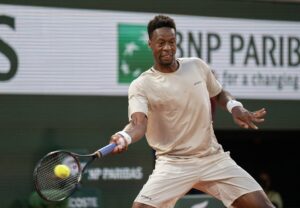Giovanni Mpetshi Perricard – big name, big stature and big talent. On the eve of the French Open, the 20-year-old Frenchman won his first ATP title by triumphing in his hometown tournament of Lyon. In the process, he catapulted himself into the world’s top 100 for the first time and confirmed that he will surely soon join all the other brilliant young men breaking through at the top of the sport.
GMP, as he will almost certainly come to be known in our abbreviated times, produced a week to remember in Lyon as he made the most of his wild card entry to win the tournament, which has become one of the biggest pre-Roland Garros events in recent years, beating a succession of far more highly ranked players to do so. In the process, he suggested that he would have a good chance of winning his first-round match at Roland Garros against Belgian veteran David Goffin and further exciting the French tennis imagination.
Big Name
As his name suggests, Giovanni Mpetshi Perricard is a mixture of Italian, Congolese and French ancestry and upbringing. His father, Ghislain Mpetshi, played football at a semi-professional level, and that sporting DNA is obviously a huge boost for any young athlete in any sport. GMP has been earmarked as a future star of French men’s tennis for a while, having excelled as a junior, particularly at the French Open in 2021, when he won the boys’ doubles title with another French prodigy, Arthur Fils, and reached the semifinals in the boys’ singles competition before losing to his doubles partner.
He has built on that impressive junior pedigree ever since, especially this year, when he excelled on the Challenger Tour, winning three titles (one in Argentina and two recently in Mexico). Nevertheless, stepping up to the ATP Tour proper is always a challenge, even for those who have excelled on the Challenger circuit, so it was fascinating to see how he would develop in Lyon.
The answer was spectacular, as he defeated Lorenzo Sonego in the first round giving him his first-ever win over a top 50 player. He then benefited from a walkover in the second round after his Japanese opponent, Yoshihito Nishioka, was forced to withdraw through illness. However, it was in his final three matches that he showed the full repertoire of his stunning power and feathery skills.
Against his diminutive compatriot, Hugo Gaston, in the quarter-final in Lyon, there was a considerable height disparity (and there will be more on Mpetshi Perricard’s formidable height in a moment). Nevertheless, Gaston, who inch for inch must be one of the most talented male players on tour, took on the relative Goliath he was facing in Mpetshi Perricard and produced one of his finest matches for a long time before finally succumbing in three sets.
Then, in the semifinal and final, Mpetshi Perricard played two extremely talented opponents who have both been inside the world’s top 20 but beat them both. Alexander Bublik would probably be the player that most young players would not want to play in a semifinal or final, because of his extraordinary ability to disrupt any other tennis player with all his dices and slices, as Arthur Fils found to his cost in the Antwerp final last year. But Mpetshi Perricard took the idiosyncratic Kazak completely in his stride to win in straight sets, 6-4, 7-5.
Then, in the final itself in Lyon, Mpetshi Perricard faced Argentina’s Tomás Martín Etcheverry, a clay-court specialist who is such a clay-court specialist that he reached the quarter-finals at Roland Garros last year. Nevertheless, despite a particularly tricky second set in which he was bread-sticked (winning only one game), Mpetshi Perricard eventually prevailed 6-4, 1-6, 7-6 (9-7). Most impressively of all, having served for the match at the end of the third set and been broken, he recovered superbly in the tie-break to take the title. It was an extremely impressive display of mental fortitude, especially for a young player in his first-ever big final.
Big Stature
It must have been a rarity for the six-foot-five Etcheverry to have been towered over in a tennis match, but against Mpetshi Perricard, he was, relatively speaking, as Mpetshi Perricard is six feet eight. Even at a time when all tennis players, indeed all sports people, are generally getting taller, that is truly a great height and obviously affords him certain enormous advantages because, as the old saying goes, you can’t teach tall.
Mpetshi Perricard has all the natural attributes to have a great serve, but in addition to its sheer speed (at times in the Lyon final, he was approaching the 150 mph mark, which relatively few young players, with the notable exception of Ben Shelton, are able to match), there seems to be a remarkably easy and straightforward service motion. Put simply, Mpetshi Perricard has all the “easy power” that is the hallmark of any really impressive young sportsperson, especially those wielding a racket or bat of any kind.
In addition to all that easy power, Mpetshi Perricard also appears to have what might be called an easy pace in that he covers the court with apparent ease. Again and again throughout the week in Lyon, his opponents hit what looked like winners, and they probably would have been winners against players with far less reach, but Mpetshi Perricard was able to take just a few prodigious steps and fire those balls back with interest.
Big Talent
However, what is most attractive about Mpetshi Perricard, especially for the tennis purist, is that he has a single-handed backhand. The single-hander is an increasingly endangered species, as proven by the fact that earlier this year, for the first time since world rankings began in 1973, there was no player with a single-handed backhand in the world’s top 10, a situation that has since been rectified by the return of Grigor Dimitrov to the highest echelon.
So, for any player to have a single-handed backhand now is rare, but for a player of Mpetshi Perricard’s height, having one is probably unprecedented. Players of great height – so, those above, say, six feet six – invariably have a double-handed backhand because of all the advantages it affords them in terms of greater strength and reliability on the backhand wing.
The fact that Mpetshi Perricard has a single-handed backhand gives him the aesthetic quality to go alongside all his obvious physical attributes: in effect, he is the perfect combination of physical beastliness and aesthetic beauty. And like all the best single-handed backhands, it is not just a thing of beauty but a weapon of power. Indeed, one or two backhand winners against Etcheverry in the final evoked memories of the very finest single-handed backhands of the last 20 years, namely those of Federer, Henin and Wawrinka.
So, Can He Be A Big Player?
So, in addition to his big name, big stature, and big talent, can Mpetshi Perricard become a big player, i.e., one who can really challenge at the top of the sport and potentially even challenge for Majors in the future? Obviously, that is a big question, but all the signs so far, especially those emerging from Lyon this week, are that he can be.
One always has to be cautious in making predictions about young players, especially perhaps young male French players; such is the desire of probably the most tennis-mad country in the world to finally produce another male Major winner for the first time in over 40 years since Yannick Noah won the French Open in 1983. Indeed, one only has to look at the example of Mpetshi Perricard’s close friend and doubles partner, Arthur Fils, to show the inherent dangers in lauding a young player too early. Fils won the Lyon tournament this time last year and, in truth, has done little on the ATP Tour since, frustrating the hopes of many that he can be a “Roi Arthur” of the men’s game in the future.
However, it seems reasonable to be more optimistic about Mpetshi Perricard. Simply because of his vastly greater height, which allows him to generate vastly greater power (especially on his serve and groundstrokes), he is likely to be a more realistic contender for the sport’s biggest prizes than the much shorter Fils. And if he can continue to develop the touch and feel that he also exhibits, especially with that glorious one-handed backhand, he can beat opponents with both power and finesse.
After the era of The Big Three/the gerontocracy in men’s tennis of the last 20 years (delete as appropriate), it genuinely feels like there is a veritable tidal wave of young male talent about to sweep away the last remnants of the old order. There are already “The New Two” of Carlos Alcaraz and Jannik Sinner, who have won Majors, but immediately behind them (or indeed at the same age as Alcaraz), you have numerous other young male players who look like they can contend for and perhaps even win Slams in the future.
Foremost among them are perhaps three of the biggest young male players, in every sense: extremely tall players with very impressive, indeed potentially all-court games, and in particular, great serves. They are Ben Shelton, Hamad “The Hammer” Medjedovic, the winner of last year’s Next Gen tournament, and Giovanni Mpetshi Perricard. With his superb win in Lyon, the latter has now joined the illustrious list of young male players who look ready to serve up a storm over the next decade or more.
Main Photo Credit: Matthias Hauer/GEPA via USA TODAY Sports






